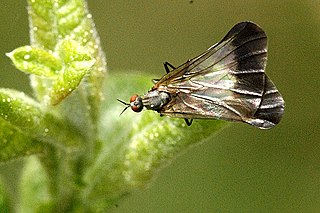
Tachydromia is a genus of hybotid flies. It is widespread around the world, with species found essentially everywhere except the polar regions and some remote islands. They are not very diverse in East and Southeast Asia, or in Africa

Trichopezinae are a subfamily of empidoid flies. They are mainly predatory flies like most of their relatives, and generally small to medium-sized, long-legged and large-eyed.

Rhamphomyia is a genus of dance flies, in the fly family Empididae. It contains more than 600 species in 8 subgenera.

Leptopeza is a genus of flies in the family Hybotidae.

Ocydromiinae is a subfamily of hybotid flies.

Hemerodromiinae are a worldwide group of predatory flies in the family Empididae with raptorial forelegs.

Brachystomatinae is a subfamily of flies belonging to the family Empididae.
Apalocnemis is a genus of flies in the family Empididae.
Aplomera is a genus of flies in the family Empididae.
Atrichopleura is a genus of flies in the family Empididae.
Hilarempis is a genus of flies in the family Empididae.

Chelipoda is a genus of flies in the family Empididae.
Cladodromia is a genus of flies in the family Empididae.
Neoplasta is a genus of flies in the family Empididae.

Bicellaria is a genus of flies in the family Hybotidae.

Drapetis is a genus of flies in the family Hybotidae.

Hoplopeza is a genus of flies in the family Hybotidae.
Micrempis is a genus of flies in the family Hybotidae.













